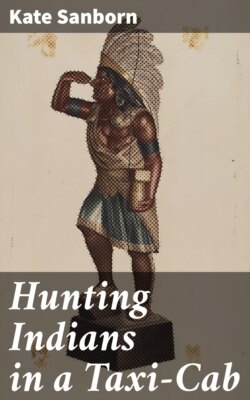Читать книгу Hunting Indians in a Taxi-Cab - Kate Sanborn - Страница 3
На сайте Литреса книга снята с продажи.
I
ОглавлениеTable of Contents
TO make my title complete, it should read “Hunting Indians in a Taxi-cab with a Camera.”
Nature lovers long since found out that the camera was the best weapon to take into the woods, and mighty hunters are now depicted as using the auto to carry them to the wild and to bring back their trophies.
It was reserved for one of my friends to follow the trail to the city of New York, as his happy hunting ground and to hire a taxi-cab there for the express purpose of hunting a desirable Tobacco Sign Indian. After two days of vain search, he came across a prize.
The Indian stood, a splendid specimen, in Bleecker street, in front of a combination barber and tobacco store; he was nine feet, seven inches tall and was standing on a two-foot pedestal, posing as a Herald of Choice Tobacco; an ignominious position for such a superb creature.
He was purchased, after a deal of haggling over the price, for he was minus a nose and was at that time suffering from a bad weather crack extending diagonally across his stomach, well up into his chest.
An old man on the same street, who was engaged to box and crate the Indian, was deeply interested in him and also in the march of Time and the disappearance of many of our traditions and relics in this comparatively new country, and said to my friend, “You do well to purchase one of these figures, for, sir, the Indians on the American continent is fastly disappearing, both in flesh and wood.”
He was next sent to a cabinet maker to receive surgical treatment—his rather serious wounds filled up and a new hawk-like nose grafted on in a clever manner.
The proud owner writes, “I then turned him over to the Sign-painter, to have his leather leggings, his warlike feathers, and a few other accessories cleaned up and retouched.
“I got into some very interesting discussions with the Sign-painter on High Art, what Art meant, and various kindred topics, while my Indian was being rejuvenated. I wish I could remember some of these conversations with the local Knight of the Brush, but we certainly discussed some of the loftiest principles in his line of paint and color.”
“Tacomus” was then sent to one of the largest and most attractive country seats in Massachusetts, where he has found a fitting home and now stands on a small knoll, his earnest face turned towards forest, hills, and streams; a noble addition to the many charms of a far famed and beautiful estate.
In his left hand Tacomus grasps a long barrelled gun, originally a flint lock, a real gun which had seen service and which he had when discovered.
Many go to gaze at him, admire, and express themselves about this new comer. One child looked way up and exclaimed, “His head is in the skies!” then timidly touched his toes and ran away.
Tacomus bears the name of an old Indian Chief, who with his sons, first sold the land which is now the town of Dudley, to Governor Winthrop’s representatives, in old Colonial Days.
My Nameless, Footless Squaw
The proud possessor of this impressive Brave says, “I felt that I had secured a great prize and an unusually handsome Indian. I also fondly thought I was the first to discover the value of our old tobacco signs for lawn decoration; but found later that a woman had seized the idea first, and about fifteen years before. Visiting her ‘Breezy Meadows,’ I noticed that she had placed two old wooden Indians near a veritable wigwam or tepee on her ‘Adopted Farm!’ So to her I take off my hat and courteously bow.”
This complimentary allusion is intended for me, but I make no claim to this honor; it is difficult and risky to try to prove oneself the first in any line of discovery and no doubt there are scores of others who have rescued these statues from oblivion, by giving them a place of refuge.
It was the enthusiasm of this friend which suggested to me the idea of collecting the best surviving specimens of the Tobacco Sign Indian and I soon found that I must take a hint from the modern nature-lover, and do most of my hunting with the aid of the camera.
